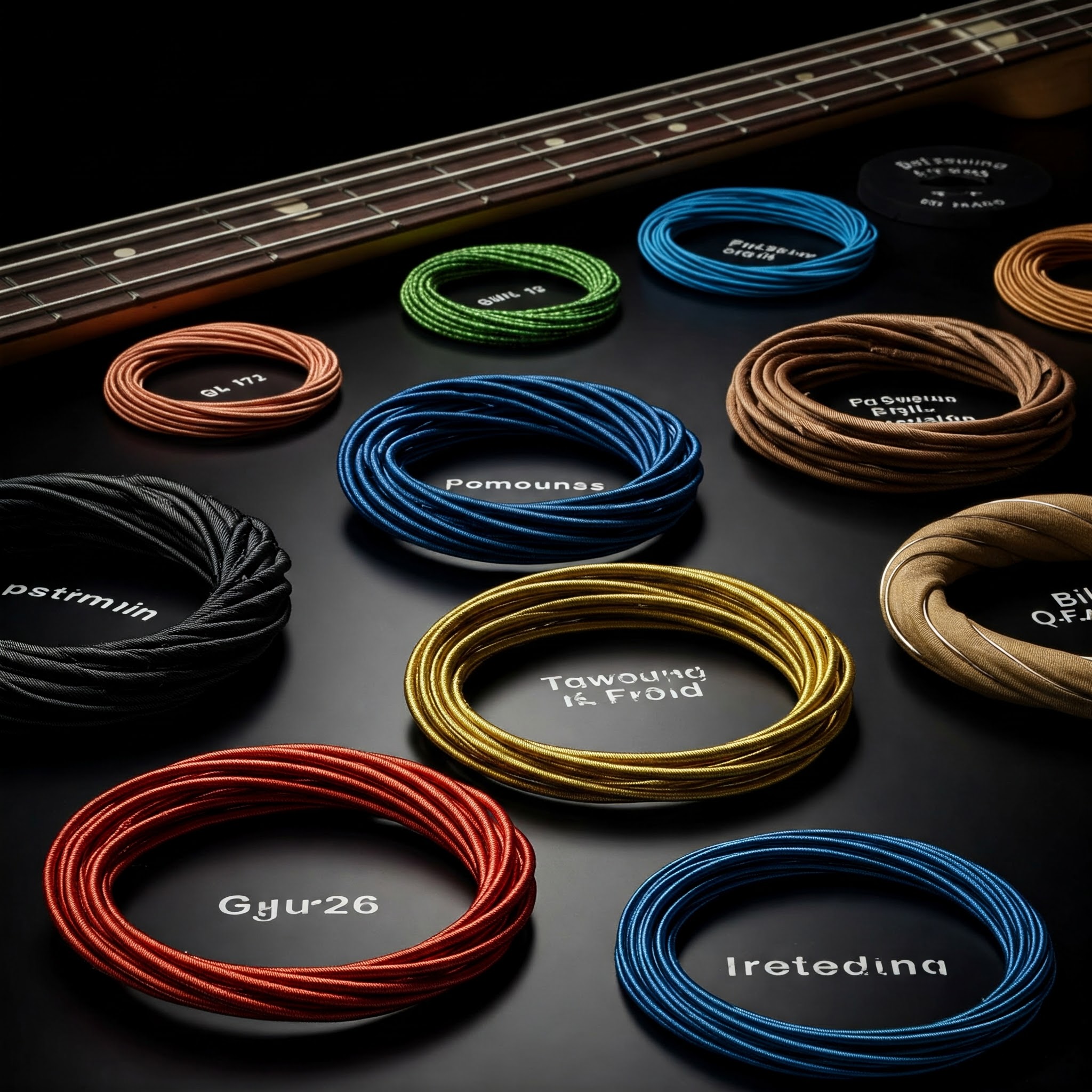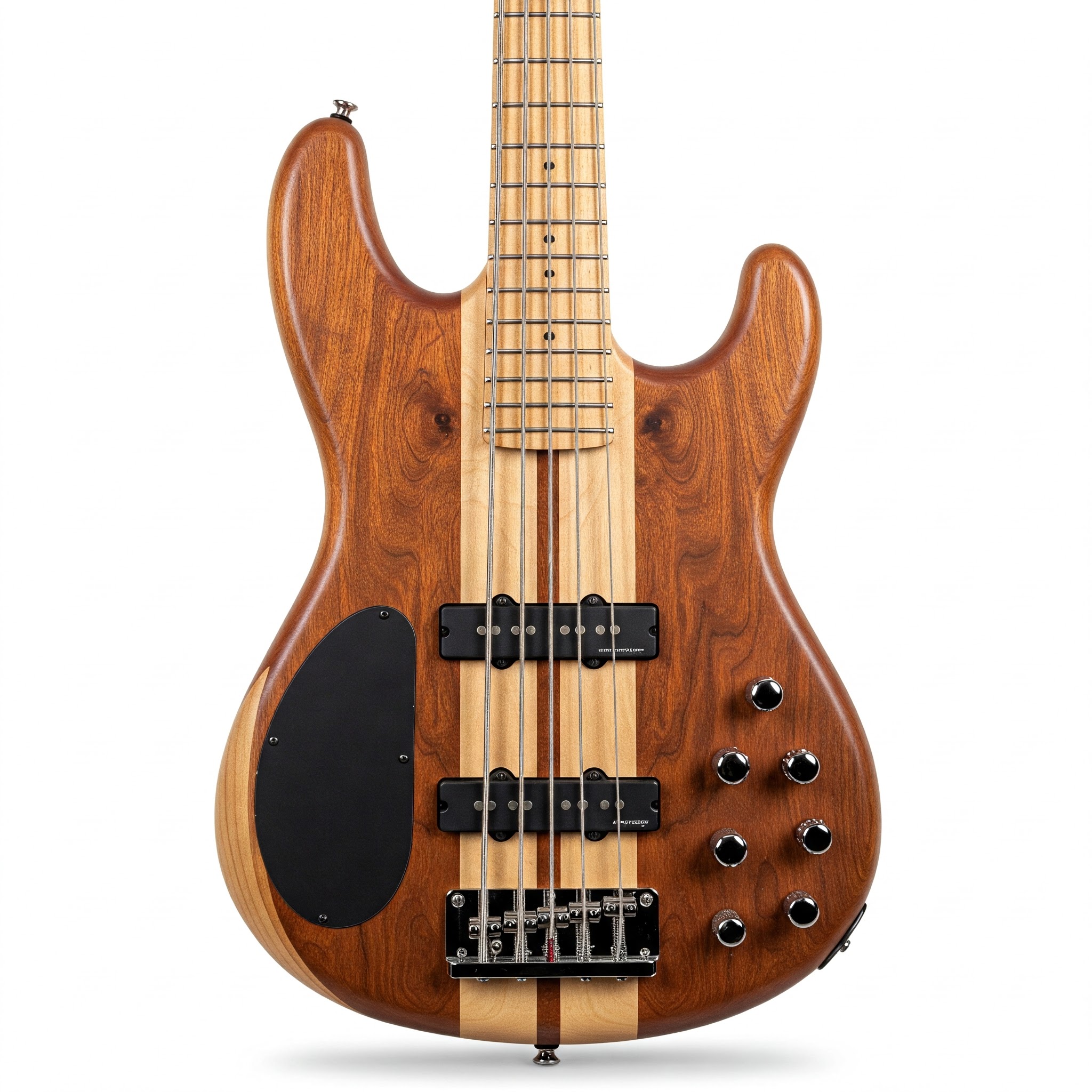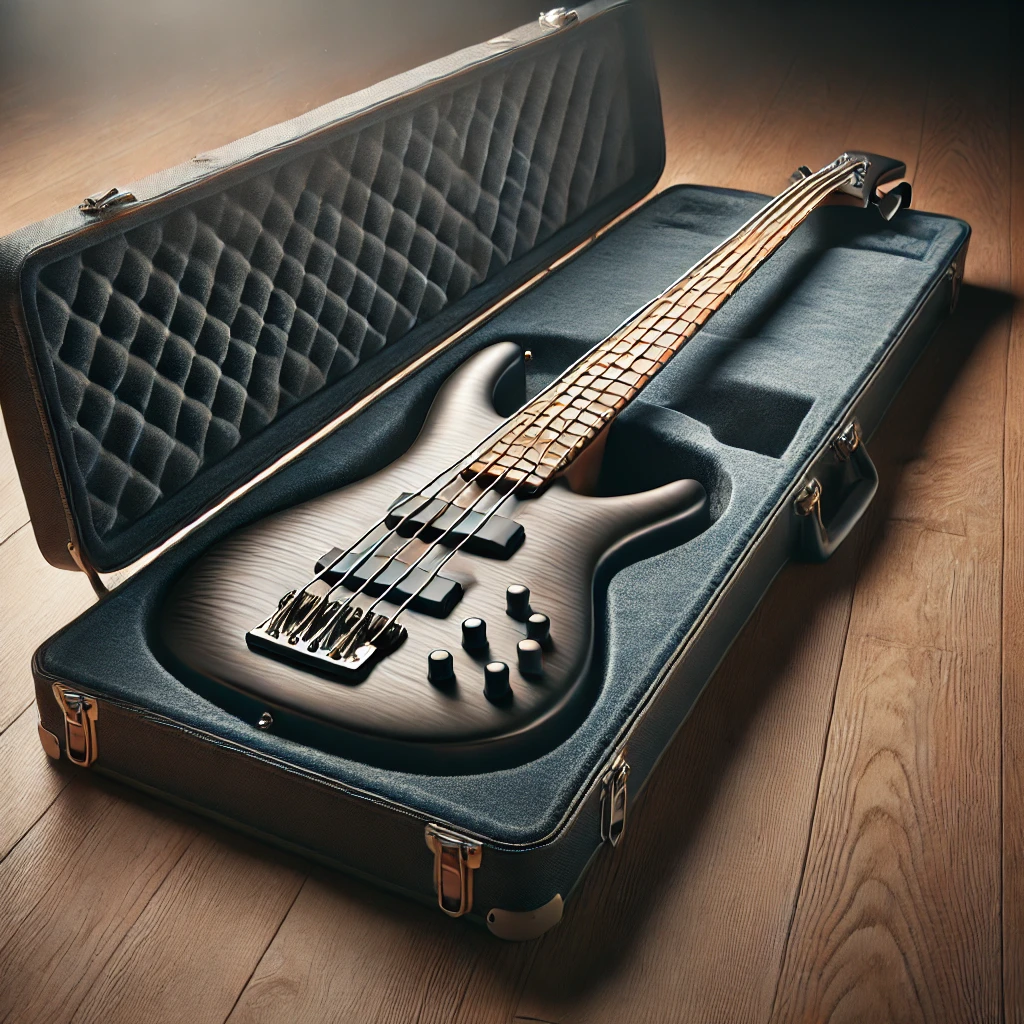When it comes to crafting your signature bass sound, few components are as crucial as your choice of bass guitar strings. As the literal connection between your fingers and your instrument, bass guitar strings fundamentally shape your tone, playability, and overall musical expression. Whether you’re a seasoned professional or just starting your journey with the bass, understanding the nuances of different string types can dramatically transform your playing experience.
✨Was this helpful? Spread the word! 🚀
Bass guitar strings come in a remarkable variety of materials, gauges, constructions, and tensions—each offering distinctive tonal characteristics and feel. From the bright punch of stainless steel to the warm thump of flatwounds, your string selection plays a pivotal role in defining your sonic identity. The best bass guitar strings for one player might be completely different for another, depending on musical style, playing technique, and personal preference.
In this comprehensive guide, we’ll explore everything you need to know about bass guitar strings, including detailed analyses of the best bass strings on the market today. We’ll examine how different materials affect tone, how gauge influences playability, and how construction methods impact durability. I’ve spent years testing countless string variations across different basses and musical contexts, and I’m excited to share insights that will help you find the perfect strings for your unique musical journey.
Whether you’re seeking the top rated bass strings for slap techniques, the warmest options for jazz, or the most durable strings for touring, this article will serve as your definitive resource. Let’s dive into the fascinating world of bass guitar strings and discover how this often-overlooked component can take your playing to new heights.
Understanding Bass Guitar String Basics
Before we explore the best bass guitar strings available today, it’s essential to understand the fundamental elements that differentiate one set from another. This knowledge will empower you to make informed decisions when selecting bass strings that align with your musical goals.
String Materials and Their Tonal Characteristics
The material composition of bass guitar strings significantly influences their sound. Here’s a breakdown of common materials and their sonic properties:
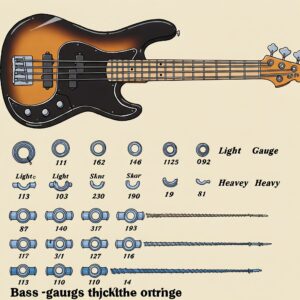
Nickel-Plated Steel: Perhaps the most popular choice for bass strings, nickel-plated steel offers a balanced tonal profile with moderate brightness and warmth. These strings provide excellent versatility across various musical genres, making them ideal for bassists who play in multiple styles. The nickel plating adds smoothness to the playing feel while reducing finger noise.
Stainless Steel: If you’re seeking brightness, clarity, and pronounced high-end response, stainless steel bass strings deliver exceptional articulation. These strings cut through dense mixes and work particularly well for slap techniques, rock, and metal genres. They’re also highly resistant to corrosion, though they may cause more finger wear due to their harder surface.
Pure Nickel: For vintage warmth and rounded low-end, pure nickel bass strings offer a distinctly old-school character. These strings produce less brightness than their stainless steel counterparts, providing a smoother, more subdued tone perfect for blues, classic rock, and traditional jazz. Their reduced tension also creates a more flexible playing experience.
Cobalt: A relatively newer material in string manufacturing, cobalt alloys create powerful magnetic relationships with bass pickups, resulting in higher output and enhanced dynamic range. These strings offer outstanding clarity without sacrificing low-end response, making them excellent for modern bass playing styles that demand both definition and depth.
Coated Strings: Many manufacturers now offer coated versions of their bass strings, applying microscopically thin polymer layers to protect against dirt, oil, and corrosion. While these coatings extend string life significantly, they can slightly dampen certain high frequencies. However, modern coating technologies have become increasingly sophisticated, minimizing tonal compromise while maximizing longevity.
String Construction: Roundwound, Flatwound, and Halfwound
Beyond material composition, the winding method used in string construction dramatically affects both tone and playability:
Roundwound: The most common construction type, roundwound bass strings feature a round wire wrapped around the core. This design produces bright, articulate tones with pronounced harmonics and sustain. Roundwounds provide excellent definition for complex playing techniques but generate more finger noise and fret wear than other constructions.
Flatwound: Favored by jazz, motown, and classic rock bassists, flatwound strings use a flat ribbon wire wrapped around the core. This creates a smooth surface that minimizes finger noise and produces a warm, thumpy tone with reduced high frequencies. These strings are gentle on fretboards and fingers but offer less sustain than roundwounds.
Halfwound/Groundwound: Representing a middle ground between round and flat constructions, halfwound (sometimes called groundwound) strings start as roundwounds but undergo a grinding process to flatten the outer surface partially. This results in a hybrid tone that combines some of the warmth of flatwounds with a touch of roundwound brightness, along with reduced finger noise.
String Gauge: Finding the Right Balance
String gauge—the physical thickness of the strings—plays a crucial role in determining both tone and playability:
Light Gauge (typically .040-.095): Lighter strings require less finger pressure, making them easier to play, particularly for beginners or those with hand issues. Tonally, they produce less low-end but offer quicker response and facilitate techniques like slapping and tapping. The tradeoff comes in reduced volume and sustain compared to heavier gauges.
Medium Gauge (typically .045-.105): Representing the most popular choice for most bassists, medium gauge strings strike a balance between playability and tonal authority. They provide substantial low-end without becoming unwieldy and work well across most playing styles and genres.
Heavy Gauge (typically .050-.115 and up): For players seeking maximum low-end response and sustain, heavy gauge strings deliver commanding presence and volume. They work particularly well for down-tuned basses and styles requiring thunderous bottom end, though they demand more finger strength and can be challenging for intricate playing techniques.
Understanding these fundamental aspects of bass guitar strings provides a solid foundation for exploring the specific products we’ll cover next. With this knowledge, you’ll be better equipped to identify which of the top rated bass strings might best suit your individual needs.
Top 10 Best Bass Guitar Strings for Different Playing Styles
After extensive testing and consultation with professional bassists across various genres, I’ve compiled this comprehensive list of the best bass guitar strings available today. Each selection excels in specific applications while maintaining professional quality standards.
1. D’Addario EXL170 Nickel Wound Bass Strings
D’Addario’s EXL170 strings represent the gold standard for all-around versatility. These nickel-plated steel roundwounds deliver exceptional balance between warmth and brightness, making them suitable for virtually any musical context. The light gauge (.045-.100) strikes an ideal compromise between playability and tone, while D’Addario’s precision winding ensures consistent performance across the entire set.
What makes these strings stand out is their remarkable consistency—every set sounds virtually identical to the last, making them reliable replacements when you need predictable tone. The nickel plating reduces finger noise without sacrificing clarity, and the hexagonal core provides excellent tuning stability even during aggressive playing.
For bassists who play in multiple bands or across various genres, these D’Addario bass strings offer exceptional value and versatility. They’re particularly effective for recording sessions where a well-balanced, neutral tone serves as an ideal foundation.
2. Ernie Ball Regular Slinky Nickel Wound Bass Strings
Ernie Ball’s Regular Slinky bass strings have earned their legendary status through decades of consistent quality. These nickel-wound strings (.050-.105) produce a slightly rounder tone than the D’Addarios, with enhanced mid-range presence that helps bass lines sit perfectly in rock and pop mixes.
The proprietary winding technique used by Ernie Ball creates strings with excellent response across all frequencies, while the slightly heavier gauge provides substantial bottom end without becoming difficult to play. These strings excel particularly in rock, blues, and country applications where tonal authority is essential.
What sets these Ernie Ball bass strings apart is their “broken-in” feel right out of the package—they don’t require extensive playing time to achieve their optimal tone. This makes them excellent choices for gigging musicians who may need to change strings shortly before performances.
3. Rotosound Swing Bass 66 Stainless Steel Bass Strings
When it comes to bright, cutting bass tone, Rotosound’s Swing Bass 66 strings deliver unparalleled clarity and presence. These stainless steel roundwounds (.045-.105) have defined the sound of rock and punk bass since the 1960s, offering exceptional articulation and harmonic content that cuts through even the densest mix.
The Rotosound bass strings feature a unique manufacturing process that results in strings with impressive response to dynamic playing. From gentle fingerstyle to aggressive picking, these strings articulate every nuance of your technique. Their distinctive bright tone makes them particularly well-suited for slap bass, picked playing, and any style where definition is paramount.
While their brightness might be excessive for some applications, these strings have defined countless classic recordings and continue to be the go-to choice for bassists seeking maximum clarity and punch.
4. GHS Precision Flats Stainless Steel Flatwound Bass Strings
For bassists exploring jazz, soul, or classic R&B territories, GHS Precision Flats offer exceptional warmth and smoothness. These stainless steel flatwounds (.045-.105) deliver the characteristic thumpy tone flatwound enthusiasts love, but with slightly more high-end clarity than traditional flatwounds.
What makes these GHS bass strings special is their “half-way” tonal character—they provide the finger-friendly smoothness and reduced noise of flatwounds while retaining enough articulation for modern playing styles. This makes them excellent transition strings for roundwound players looking to explore flatwound territories without committing to extremely dark tonality.
Their tension is slightly lower than many competing flatwounds, making them more approachable for players accustomed to roundwound feel. With excellent intonation and remarkable longevity (flatwounds typically last many times longer than roundwounds), these strings represent an excellent value despite their higher initial cost.
5. DR Strings Hi-Beam Stainless Steel Bass Strings
For bassists who demand maximum output and presence, DR Hi-Beams deliver extraordinary brightness and punch. These stainless steel roundwounds (.045-.105) are hand-wound using DR’s proprietary techniques, resulting in strings with exceptional sustain and powerful fundamentals.
The DR bass strings feature a round core (unlike the hexagonal cores used by many manufacturers), which contributes to their distinctive feel and tonal character. This construction creates strings with excellent flexibility and reduced tension, making them surprisingly comfortable despite their powerful output.
Hi-Beams excel particularly in contexts where the bass needs to function as both a rhythmic and melodic instrument—their clarity makes them ideal for intricate bass solos, while their robust fundamentals ensure they never lose their rhythmic authority. These strings are favorites among progressive rock, fusion, and metal bassists.

6. Thomastik-Infeld Jazz Bass Flatwound Strings
At the premium end of the spectrum, Thomastik-Infeld’s Jazz Bass flatwounds represent perhaps the finest flatwound strings available today. Hand-made in Vienna using proprietary alloys and winding techniques, these strings (.043-.106) produce a sophisticated, refined tone that justifies their higher price point.
What makes these Thomastik bass strings extraordinary is their remarkable balance between warmth and clarity—they deliver the smooth, thumpy character flatwound enthusiasts seek, but with an articulation and definition typically associated with roundwounds. This unique tonal profile makes them versatile enough for jazz, fusion, studio recording, and any context where sophisticated bass tone is required.
Their tension profile is meticulously calibrated to provide consistent feel across all four strings, and their longevity is exceptional even by flatwound standards. For serious jazz bassists or recording professionals, these strings represent the pinnacle of flatwound technology.
7. Elixir Nanoweb Light/Medium Bass Strings
For bassists tired of frequent string changes, Elixir’s Nanoweb-coated strings offer remarkable longevity without significant tonal compromise. These nickel-plated steel roundwounds (.045-.105) feature a microscopically thin polymer coating that protects against corrosion, dirt, and oil while preserving most of the uncoated string tone.
What distinguishes Elixir bass strings from other coated options is the sophisticated Nanoweb coating that adds minimal mass to the string, allowing them to vibrate more naturally than competitors with thicker coatings. The result is a string that maintains its “new string sound” for weeks or even months longer than uncoated alternatives.
While slightly more expensive than standard strings, their extended lifespan makes them economical in the long run, particularly for bassists who perspire heavily or play in humid environments. Their consistent tone makes them excellent choices for touring musicians who can’t always change strings as frequently as they’d like.
8. La Bella 760FS Deep Talkin’ Bass Flatwound Strings
For bassists seeking authentic vintage tone, La Bella’s Deep Talkin’ Bass strings deliver unparalleled old-school character. These stainless steel flatwounds (.052-.110) are manufactured using techniques largely unchanged since the 1950s, resulting in strings with profound warmth and substantial tension.
The La Bella bass strings feature the highest tension of any strings in this roundup, creating a distinctive playing experience that influences both tone and technique. Their substantial resistance provides exceptional sustain and fundamental strength, while their smooth surface eliminates finger noise entirely.
These strings excel in traditional contexts like straight-ahead jazz, early rock and roll, and any setting where authentic vintage bass tone is required. Their remarkable longevity makes them excellent long-term investments despite their premium price point.
9. Fender 9050L Stainless Flatwound Bass Strings
Fender’s 9050L flatwounds offer excellent quality at a midrange price point, making them ideal introductions to the flatwound world. These stainless steel flatwounds (.045-.100) deliver classic thump with slightly more brightness than traditional flatwounds like the La Bellas.
What makes these Fender bass strings noteworthy is their balance between authentic flatwound character and modern playability. Their tension is moderate, making them accessible to players accustomed to roundwounds, while their tonal profile includes enough high-mid presence to work in contemporary musical contexts.
These strings have become favorites among indie rock bassists seeking alternatives to standard roundwound sounds, as well as traditional players who appreciate their blend of vintage warmth and modern clarity. Their exceptional consistency makes replacement sets highly predictable.
10. Warwick Black Label 5-String Bass Strings
For five-string bass players, Warwick’s Black Label strings provide exceptional balance across all five strings. These nickel-plated steel roundwounds (.045-.135) are designed specifically to ensure the notorious B string doesn’t sound disconnected from the rest of the set—a common problem with many five-string sets.
The Warwick bass strings feature progressive tension design, where the lower strings have proportionally higher tension to maintain consistent feel across the entire set. This creates a more coherent playing experience and eliminates the “floppy B string” issue that plagues many five-string basses.
Their balanced tone works particularly well with active electronics, making them excellent choices for modern bass styles including fusion, progressive metal, and contemporary gospel. While our focus is primarily on four-string sets, these represent the best option for five-string players seeking consistent tone across all strings.
| String Brand | Material | Construction | Best For | Longevity | Price Range |
|---|---|---|---|---|---|
| D’Addario EXL170 | Nickel-Plated Steel | Roundwound | All-purpose versatility | Average | $$ |
| Ernie Ball Regular Slinky | Nickel-Plated Steel | Roundwound | Rock, blues, country | Average | $$ |
| Rotosound Swing Bass 66 | Stainless Steel | Roundwound | Rock, punk, slap | Average | $$ |
| GHS Precision Flats | Stainless Steel | Flatwound | Jazz, R&B, smooth playing | Very High | $$$ |
| DR Hi-Beam | Stainless Steel | Roundwound | Progressive, metal, fusion | Above Average | $$$ |
| Thomastik-Infeld Jazz Bass | Proprietary Alloy | Flatwound | Jazz, studio recording | Exceptional | $$$$ |
| Elixir Nanoweb | Nickel-Plated Steel (Coated) | Roundwound | Long-lasting performance | Very High | $$$ |
| La Bella 760FS | Stainless Steel | Flatwound | Vintage jazz, traditional | Exceptional | $$$ |
| Fender 9050L | Stainless Steel | Flatwound | Indie rock, versatile | Very High | $$ |
| Warwick Black Label 5-String | Nickel-Plated Steel | Roundwound | 5-string balance | Above Average | $$$ |
💬 Just one click – help others make better buying decisions too!😊
🔍 Find Your Perfect Bass Guitar Strings Today! 🎸
➡ Don’t settle for subpar tone any longer! Click on any of the highlighted product recommendations throughout this article to check current pricing and availability on Amazon. Your ideal bass sound is just a string change away!

How to Choose the Right Bass Guitar Strings for Your Needs
Selecting the best bass strings for your specific requirements involves considering multiple factors beyond simple brand preferences. Let’s explore the key considerations that should guide your decision-making process.
Consider Your Musical Style
Different genres often demand different tonal characteristics from your bass:
Rock and Metal: These high-energy genres typically benefit from strings with excellent projection and clarity. Roundwound stainless steel options like Rotosound Swing Bass or DR Hi-Beams can provide the punch and definition needed to cut through distorted guitars and aggressive drums.
Jazz and Blues: The warm, sophisticated tones these genres often require are typically best served by flatwound or halfwound strings. Options like Thomastik-Infeld Jazz Bass strings or La Bella Deep Talkin’ Bass deliver the smooth, mellow characteristics perfect for walking bass lines and subtle accompaniment.
Funk and R&B: These groove-oriented styles demand strings with excellent response to dynamic playing. Nickel-plated roundwounds like D’Addario EXL170 or Ernie Ball Regular Slinkys provide the balanced tone needed for everything from thumb-slapping to finger-popping techniques.
Studio Recording: In recording contexts, versatility is paramount. Strings with balanced frequency response like Elixir Nanowebs or D’Addario EXL170s provide excellent all-around performance that engineers can easily shape during mixing.
Matching Strings to Your Instrument
Your bass guitar’s inherent characteristics should influence your string selection:
Active vs. Passive Electronics: Basses with active electronics (featuring battery-powered preamps) typically have greater tonal flexibility, allowing them to work well with a wider range of strings. Passive basses, however, rely more heavily on string choice to shape their fundamental tone. For passive basses, the string selection becomes even more crucial in defining your sound.
Scale Length: The scale length of your bass affects string tension. Longer-scale basses (34″ and above) typically require less tension from strings to achieve proper pitch, while shorter-scale instruments (30-32″) need higher tension to maintain proper intonation. Some manufacturers like D’Addario offer specific sets designed for short-scale basses.
Wood Composition: The tonewoods used in your bass interact with your strings to shape your overall sound. Brighter woods like maple might pair well with warmer strings like pure nickel roundwounds, while darker-sounding woods like mahogany might benefit from the clarity of stainless steel strings.
Practical Considerations
Beyond tonal factors, several practical aspects should inform your string selection:
Playing Frequency: How often do you play? Bassists who play frequently in demanding environments (like touring musicians) might benefit from coated strings like Elixirs that resist corrosion and maintain their tone longer. Casual players might prioritize tone over longevity.
Budget Constraints: While premium strings offer exceptional performance, their cost can add up over time. Brands like D’Addario and Ernie Ball offer excellent quality at moderate price points, making them suitable for bassists who change strings frequently or operate on limited budgets.
Physical Comfort: String gauge and construction affect playability. Players with hand issues or beginners might prefer lighter gauge strings that require less pressure to fret notes. Similarly, the smooth surface of flatwounds can be gentler on fingers than the ribbed texture of roundwounds.
Experimentation is Key
Perhaps the most important advice about choosing bass guitar strings is to experiment regularly. Even experienced bassists continue discovering new string combinations that enhance their playing. Consider keeping a journal of different strings you’ve tried, noting their characteristics and how they complemented your instrument and playing style.
Many bassists also mix and match strings from different sets or manufacturers, creating custom combinations that address specific tonal needs. Don’t be afraid to break out of conventional string combinations if your ears tell you a unique configuration works better for your playing.
How to Properly Maintain Your Bass Guitar Strings
Even the best bass strings will deteriorate without proper care. Here are essential maintenance practices to maximize string life and tone:
Cleaning After Playing
The simplest yet most effective maintenance habit is wiping down your strings immediately after playing. Perspiration, skin oils, and environmental contaminants accelerate corrosion, so removing these substances promptly extends string life significantly.
✅ Use a clean, lint-free cloth to wipe down the entire length of each string after every playing session.
✅ For more thorough cleaning, specialized string cleaners like GHS Fast-Fret or D’Addario XLR8 can dissolve accumulated grime without harming your strings or fingerboard.
❌ Avoid household cleaners or alcohol-based products, which may damage your bass’s finish or fingerboard.
Proper Storage Practices
How you store your bass significantly impacts string longevity:
✅ Store your bass in a case with stable humidity (ideally between 45-55% relative humidity).
✅ Use silica gel packs in your case if you live in a humid environment.
✅ Consider loosening the strings slightly if storing the bass for extended periods, though opinions vary on whether this actually helps.
❌ Avoid extreme temperature fluctuations, which can cause metal strings to expand and contract, potentially accelerating wear.
When to Replace Your Strings
Knowing when to change your bass strings is partly subjective, but several indicators suggest replacement may be necessary:
✅ Visible corrosion or discoloration, particularly in the areas where you play most frequently.
✅ Noticeable loss of sustain compared to new strings.
✅ Difficulty maintaining proper intonation despite adjustments.
✅ Uneven response across different strings or positions.
For most actively playing bassists using roundwound strings, changing every 1-3 months maintains optimal tone. Flatwound players might go 6-12 months or even years between changes, as these strings often improve with age until they eventually fail.
Pro Tip: String Rotation
If budget constraints make frequent full string changes challenging, consider the rotation method:
- Replace just the most worn strings (typically E and A) when needed.
- Move the existing A string to the D position.
- Move the existing D string to the G position.
- Install new strings in the E and A positions.
This technique maximizes value by acknowledging that lower strings typically wear faster than higher ones.
Comparing Different Bass Guitar String Gauges
String gauge significantly impacts both tone and playability. Let’s compare the characteristics of different gauge ranges:
Extra Light (.040-.095)
Tonal Characteristics:
- Less low-end thunder
- Quick response
- Excellent articulation for complex passages
- Less sustain than heavier gauges
Playability Factors:
- Minimal finger strain
- Lower tension makes bending easier
- Excellent for fast playing techniques
- May feel “loose” to players accustomed to heavier strings
Best Applications:
- Beginners still developing finger strength
- Bassists with hand issues like arthritis
- Players focusing on complex technical passages
- Fretless bass (reduced wear on fingerboard)
Light (.045-.100)
Tonal Characteristics:
- Balanced response across frequency spectrum
- Good fundamental without sacrificing articulation
- Moderate sustain
- Versatile sonic profile
Playability Factors:
- Responsive to dynamic playing
- Comfortable tension for most players
- Good balance between ease of playing and solid feel
- Most popular gauge for good reason
Best Applications:
- All-around playing
- Studio recording
- Players who switch between techniques frequently
- Ideal starting point for most bassists
Medium (.050-.105)
Tonal Characteristics:
- Strong fundamental frequencies
- Robust low end
- Good sustain
- Slightly reduced high-end response compared to lighter gauges
Playability Factors:
- Require moderate finger strength
- Less string displacement when played aggressively
- More resistance when slapping or popping
- Solid feel under the fingers
Best Applications:
- Rock and metal genres
- Players with forceful picking/plucking techniques
- Bassists seeking maximum projection without extreme tension
- Drop tunings (down one or two semitones)
Heavy (.055-.110 and up)
Tonal Characteristics:
- Maximum low-end response
- Powerful fundamental frequencies
- Excellent sustain
- Reduced high frequencies
Playability Factors:
- Demand significant finger strength
- Higher tension reduces ease of playability
- Minimal string buzz even with aggressive playing
- Substantial resistance under fingers
Best Applications:
- Extreme drop tunings
- Metal and doom genres
- Five-string bass (particularly for consistent B string performance)
- Players seeking maximum volume and projection
Many experienced bassists eventually settle on hybrid gauge sets that combine elements from different standard gauges. For example, a set might use medium gauge for the E and A strings, but light gauge for the D and G strings, creating a balanced tension profile that suits particular playing techniques.
The Impact of Scale Length on String Selection
It’s important to note that the same string gauge will feel different on basses with different scale lengths:
- Long Scale (34-35″): The standard for most bass guitars. Gauge recommendations typically reference this scale.
- Medium Scale (32-33″): Same gauge feels approximately 20% tighter than on long scale.
- Short Scale (30-31″): Same gauge feels approximately 35% tighter than on long scale.
When switching between basses with different scale lengths, consider adjusting your string gauge accordingly to maintain consistent feel. For example, if you use medium gauge (.050-.105) on a long-scale bass, you might prefer light gauge (.045-.100) on a medium-scale instrument.
🔍 Find Your Perfect Bass Guitar Strings Today! 🎸
➡ Don’t settle for subpar tone any longer! Click on any of the highlighted product recommendations throughout this article to check current pricing and availability on Amazon. Your ideal bass sound is just a string change away!
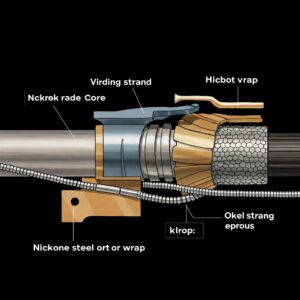
Special Considerations for Extended Range and Alternative Basses
As bass design continues evolving, string manufacturers have developed specialized options for instruments beyond the standard four-string configuration.
5-String Bass String Sets
Five-string basses introduce specific challenges for string design. The additional low B string requires careful engineering to maintain consistent tone across all five strings. When selecting five-string sets, consider these factors:
String Balance: The best 5-string sets feature progressively increasing tension across strings, ensuring the B string doesn’t feel disproportionately looser than the others. Warwick Black Label and D’Addario NYXL45130 sets excel in this regard.
Core Design: Many quality 5-string sets utilize larger cores for the B string, providing stability without excessive thickness. This design choice helps articulation and reduces the “piano wire” effect some B strings exhibit.
B String Composition: Some manufacturers use different wrap wire or core materials specifically for the B string to enhance its performance. Look for sets advertising “balanced tension” or “specially designed B string” in their descriptions.
6-String Bass String Sets
Six-string basses add both a low B and a high C string, creating even greater challenges for consistent feel and tone. When selecting strings for six-string basses:
Consider String Tension Carefully: The extreme range of a six-string bass means standard sets might feel uncomfortably tight on the C string or too loose on the B. Brands like Kalium specialize in balanced-tension sets designed specifically for extended-range instruments.
Custom Gauges May Be Necessary: Many serious six-string players eventually create custom sets by purchasing individual strings rather than pre-packaged sets. This allows fine-tuning of tension across all six strings.
Material Choices Become More Critical: With six strings, the tonal difference between nickel, steel, and coated strings becomes even more pronounced. Finding the right material that works across the instrument’s entire range requires careful experimentation.
Piccolo Bass and Nashville Tuning
Some specialized tuning approaches require specific string considerations:
Piccolo Bass (tuned an octave higher than standard) typically requires much lighter gauge strings, often adapted from guitar sets. D’Addario produces specific piccolo bass sets that balance proper tension with the higher pitch requirements.
Nashville Tuning (using the high octave strings from a 12-string guitar set) similarly requires specialized string selections that can withstand bass scale lengths while tuned to higher pitches. Options like La Bella’s 750N-B set are specifically designed for these applications.
The Environmental Impact of Bass String Manufacturing
As environmental awareness grows within the musical instrument industry, several string manufacturers have begun addressing sustainability concerns in their production processes.
Environmentally Conscious Options
Several brands have implemented more sustainable practices:
D’Addario has pioneered string recycling programs and uses environmentally friendly packaging materials for many products. Their String Recycling Program allows players to return used strings for proper recycling.
GHS Strings has reduced packaging waste and implemented more efficient manufacturing processes that reduce energy consumption.
Rotosound has updated their manufacturing facilities to reduce carbon footprint and waste production during string making.
The Longevity Factor
Perhaps the most environmentally friendly approach to strings is maximizing their usable lifespan:
✅ Proper maintenance extends string life, reducing consumption and waste.
✅ Coated strings, while initially more expensive, create less waste through their extended lifespan.
✅ Flatwound strings typically last several times longer than roundwounds, making them environmentally sound choices despite higher initial cost.
When considering your environmental impact as a bassist, remember that the most sustainable string is one you don’t need to replace. Investing in higher-quality strings and maintaining them properly reduces both cost and environmental impact over time.
🔍 Find Your Perfect Bass Guitar Strings Today! 🎸
➡ Don’t settle for subpar tone any longer! Click on any of the highlighted product recommendations throughout this article to check current pricing and availability on Amazon. Your ideal bass sound is just a string change away!
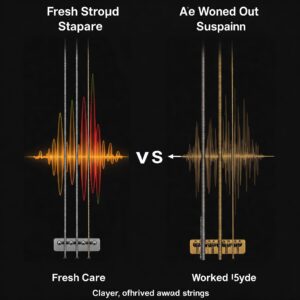
Expert Tips for Bass String Selection and Installation
After decades of experimentation and professional experience, I’ve developed several practical approaches to string selection and installation that can significantly improve your results:
Finding Your Perfect String Type
Rather than randomly trying different brands, I recommend a methodical approach to discovering your ideal strings:
- Start with materials: Try one quality set each of nickel-plated steel, stainless steel, pure nickel, and coated strings to determine which basic material suits your preferences.
- Explore constructions: Once you’ve identified your preferred material, experiment with roundwound, flatwound, and halfwound versions to further refine your preference.
- Fine-tune gauges: After establishing material and construction preferences, try light, medium, and heavy gauge sets to determine your ideal tension.
- Compare brands: Only after completing the above steps should you compare different brands of similar specifications to identify subtle differences in manufacturing that might better suit your needs.
This systematic approach prevents the overwhelming experience of random string testing and helps you discover your preferences more efficiently.
Professional Installation Techniques
Proper string installation significantly impacts both tone and durability:
✅ Stretch new strings properly: After installation, gently pull each string away from the fingerboard along its length to pre-stretch the material. This accelerates the stabilization process and improves tuning stability.
✅ Consider string break angle: Ensure strings have appropriate break angles over the nut and bridge. Too shallow an angle can cause buzzing or poor sustain; too extreme can create excessive pressure on components.
✅ Manage excess string length: When trimming excess string at the tuning pegs, leave approximately 1.5-2 inches beyond the post to prevent slippage while avoiding excessive coiling that can create unwanted resonances.
✅ Optimize winding pattern: Strings should wind downward on the tuning post, creating clean wraps without overlapping. This improves tuning stability and prevents kinking that can lead to premature string failure.
Breaking In New Strings
New bass strings typically require a break-in period before reaching their optimal tone:
- After installation, tune to pitch and play for 15-20 minutes, focusing on full-hand techniques that work the strings thoroughly.
- Re-tune (new strings will typically go flat during initial playing) and repeat this process several times during the first few days.
- For roundwound strings, expect the initial extreme brightness to mellow slightly over the first 2-4 hours of playing time.
- For flatwound strings, expect a break-in period of 10-20 hours before they develop their characteristic warm tone fully.
Understanding this break-in process helps prevent premature string replacement due to misunderstanding how the tone will eventually settle.
String Maintenance Tools Worth Investing In
Several affordable tools can significantly extend string life:
String cleaner solutions like GHS Fast-Fret or D’Addario XLR8 dissolve finger oils before they can corrode your strings.
Microfiber polishing cloths remove debris without scratching string surfaces or leaving lint behind.
Humidity control systems in your case prevent environmental damage to both strings and instrument.
String winders with built-in clippers make string changes faster and more convenient.
These modest investments pay dividends through extended string life and improved tonal consistency.
Specialty Bass Guitar Strings for Unique Applications
Beyond standard bass strings, several specialized options address specific playing requirements or tonal goals:
Tapewound Strings
Tapewound strings feature a textile tape (typically nylon) wrapped around a standard core, creating a uniquely smooth playing surface and mellow tone:
Tonal characteristics: Exceptionally warm with minimal high frequencies, tapewounds produce an upright bass-like thump that works beautifully for traditional jazz, folk, and acoustic-oriented music.
Playing feel: The nylon wrapping creates the smoothest possible surface, eliminating finger noise entirely and providing a gentle feel that’s easier on the fingers than even flatwounds.
Longevity: The nylon wrapping resists corrosion completely, giving tapewounds remarkable longevity—often several years of regular playing before replacement becomes necessary.
Popular options include the La Bella 760N-B Black Nylon Tape Wound strings, which deliver authentic upright-like tone, and D’Addario ETB92 Tapewound strings, which offer slightly more modern clarity while maintaining the characteristic warmth.
Color-Coated Strings
For bassists concerned with visual aesthetics alongside tone, color-coated strings provide distinctive appearance options:
DR Strings NEON series offers vibrant fluorescent colors that glow under UV light, making them popular for stage performances where visual impact matters. Despite their coating, these strings maintain respectable tone and playability.
Aurora Strings produce multi-colored bass sets where each string features a different color, helping beginners visually identify strings while adding visual flair to an instrument.
While primarily chosen for their appearance, quality color-coated strings like those from DR maintain professional-grade tone and durability, making them viable options beyond mere novelty.
Strings for Extended Range Techniques
Some specialized strings are engineered specifically for extended playing techniques:
Double Ball-End Strings like those manufactured by Galli Strings facilitate rapid string changes and are essential for certain headless bass designs.
Singles for Custom Sets allow players to create personalized string sets tailored to specific techniques. Companies like Kalium and La Bella offer extensive individual string options for creating custom sets.
Strings for Tapping Techniques like D’Addario’s light gauge XL Nickel sets provide reduced tension that facilitates two-handed tapping approaches popularized by players like Billy Sheehan and Victor Wooten.
How Bass Guitar Strings Impact Recording and Live Performance
Understanding how your string choice affects different performance contexts can help you select the optimal strings for specific applications.
Recording Studio Considerations
In studio environments, several string-related factors become particularly important:
New vs. Broken-In: While conventional wisdom suggests always recording with fresh strings, many engineers prefer strings with 3-5 hours of playing time, as they retain clarity while losing the sometimes excessive “zing” of brand-new strings.
Noise Factors: Studio microphones capture subtle details that stage environments might mask. Flatwound or tapewound strings significantly reduce finger noise that might otherwise require noise reduction during mixing.
Consistency Between Takes: During multi-day recording sessions, significant tonal changes from aging strings can create consistency problems. Consider changing strings midway through lengthy sessions to maintain tonal continuity.
Engineer Preferences: Many recording engineers prefer the balanced output and reduced finger noise of nickel-plated roundwounds or halfwounds, as these provide enough clarity without requiring extensive EQ adjustments.
Live Performance Requirements
Stage environments create different demands for your bass strings:
Durability Becomes Critical: The heat from stage lights and increased playing intensity accelerate string wear during live performances. Coated strings or stainless steel options may better withstand these challenging conditions.
Projection Through the Mix: Live sound systems may benefit from strings with enhanced midrange presence (like Ernie Ball Regular Slinkys) that help the bass cut through without requiring extreme EQ adjustments.
Visual Considerations: For performers who incorporate visual techniques like slapping or tapping, string selection can impact visibility. Brighter-colored strings or even DR’s NEON series can help audiences see intricate playing techniques from a distance.
Backup Planning: Experienced touring bassists often bring pre-stretched backup sets for emergency string replacements, ensuring consistent tone even if breakage occurs mid-performance.
🔍 Find Your Perfect Bass Guitar Strings Today! 🎸
➡ After exploring the comprehensive information about bass guitar strings in this guide, you’re now equipped to make an informed decision about which strings will best suit your playing style, instrument, and musical preferences. Whether you’re seeking bright, articulate tones for slap techniques or deep, warm sounds for jazz, the perfect set of strings awaits.
Don’t settle for subpar tone any longer! Click on any of the highlighted product recommendations throughout this article to check current pricing and availability on Amazon. Your ideal bass sound is just a string change away!

The Science Behind Bass Guitar String Construction
Understanding the technical aspects of string manufacturing helps inform more sophisticated string selection decisions.
Core Types and Their Impact
Bass strings utilize different core designs that fundamentally affect their performance:
Hex Core strings feature a hexagonal-shaped center wire that creates small gaps where the wrap wire contacts the core. This design promotes overtones and brightness while increasing sustain. Most modern roundwound strings use hex cores.
Round Core strings utilize a round center wire that creates more continuous contact with the wrap wire, resulting in warmer tone with fewer overtones and slightly lower tension. DR and certain vintage-inspired strings use round cores.
Ribbon Core strings, less common but preferred by some manufacturers for specialty strings, use a flat ribbon of metal as the core. This design creates unique tension characteristics and tonal response, particularly for lower tunings.
Tension Profiles and String Response
String tension directly influences both playability and tone:
High-Tension Sets like those from La Bella and Thomastik-Infeld require more finger pressure but reward players with exceptional sustain and fundamental strength. These strings respond best to confident, forceful playing techniques.
Medium-Tension Sets from brands like D’Addario and Ernie Ball offer balanced response that works well for versatile playing styles, providing enough resistance for good tone without requiring excessive hand strength.
Low-Tension Sets like D’Addario Flex Steels or certain DR sets emphasize playability and quick response at the expense of some output volume. These strings excel for technical styles requiring nimble fingerwork.
Understanding tension profiles helps bassists match strings to both their physical playing characteristics and tonal preferences.
Material Science Innovations
Recent advances in metallurgy have created new possibilities in string design:
Composite Alloys like those used in D’Addario NYXL or Ernie Ball Cobalt strings utilize sophisticated metal blends that optimize magnetic response and durability beyond traditional materials.
Advanced Coatings have evolved from early versions that significantly compromised tone to modern nano-level applications like Elixir Nanoweb and D’Addario EXP that protect strings while minimizing tonal impact.
Cryogenic Processing, employed by DR in their “Black Beauties” and similar lines, uses extreme cold treatment to relieve mechanical stresses in the metal, potentially extending string life and improving tonal consistency.
Budget Considerations When Buying Bass Guitar Strings
Bass string prices vary widely, from budget options under $20 to premium sets exceeding $60. Understanding what influences these price differences helps bassists make cost-effective decisions.
Value Analysis of Different Price Ranges
Budget Strings ($15-25): Brands like Ernie Ball Regular Slinky, D’Addario EXL, and Fender 7150s offer excellent performance-to-price ratios. These strings provide professional-quality tone but may wear more quickly than premium options. Best for players who change strings frequently or are still exploring preferences.
Mid-Range Strings ($25-40): Options like DR Hi-Beams, Rotosound Swing Bass, and D’Addario ProSteels deliver enhanced durability and tonal refinement over budget options. These strings typically offer better manufacturing consistency and longer life, making them good values for serious players.
Premium Strings ($40-60+): High-end options like Thomastik-Infeld Jazz Flats, La Bella Deep Talkin’ Bass, and certain specialty sets offer distinctive tones unavailable at lower price points. While expensive, their exceptional longevity (particularly for flatwounds) can make them economical long-term investments.
Cost Per Hour of Play
A more sophisticated way to evaluate string value considers playing time rather than calendar life:
Flatwound strings might cost twice as much as roundwounds initially, but often last 5-10 times longer, making them more economical for players who use them regularly.
Coated strings carry a 30-40% price premium but typically last 3-4 times longer than uncoated equivalents, potentially offering better long-term value despite higher initial cost.
Strategic Approaches to String Budgeting
Several strategies can optimize your string budget without compromising tone:
Hybrid Approach: Use premium strings on your main performance instrument while keeping more affordable options on practice basses.
Seasonal Adjustment: Some players use longer-lasting coated or flatwound strings during humid summer months when corrosion accelerates, switching to standard strings during drier seasons.
Bulk Purchasing: Many manufacturers offer significant discounts on multiple sets purchased simultaneously, reducing per-set costs for players who know their preferences.
Common Questions About Bass Guitar Strings
Let’s address some frequently asked questions about bass strings that often confuse both beginners and experienced players.
How Often Should I Change My Bass Strings?
String replacement frequency depends on several factors:
For roundwound strings, signs that replacement is needed include:
- Visible corrosion or discoloration
- Loss of tonal clarity, particularly in higher frequencies
- Difficulty maintaining consistent intonation
- Uneven response across the string length
Most active players change roundwounds every 1-3 months, though playing frequency, perspiration levels, and environmental factors can influence this timeline.
For flatwound and tapewound strings, replacement is typically needed only when:
- String response becomes noticeably dull
- Intonation problems develop
- Physical damage occurs to the string
Many flatwound players change strings only every 1-2 years or even longer, as these strings often improve with age until eventually failing.
Should Bass Strings Be Boiled to Restore Them?
The practice of boiling used bass strings to remove accumulated dirt and oils remains controversial:
Potential benefits include:
- Removal of finger oils and debris that dampen vibration
- Temporary restoration of some high-frequency response
- Extended usable life for expensive strings
Significant drawbacks include:
- Incomplete cleaning as oils penetrate between wrap wires
- Potential acceleration of corrosion after boiling
- Inconsistent results between strings
- Possible weakening of string structure
Most professional bassists consider boiling a temporary solution at best, suitable for emergency situations rather than regular practice. Modern string cleaning products offer better results without potential string damage.
How Should I Store Spare Bass Strings?
Proper storage of unused strings preserves their quality:
✅ Keep strings in their original sealed packages until needed.
✅ Store in a cool, dry environment away from extreme temperatures.
✅ Consider vacuum-sealed storage for long-term preservation.
❌ Avoid exposure to humidity, which can accelerate corrosion even in unopened packages.
Properly stored bass strings can maintain their “new string” quality for several years, making bulk purchasing a viable option for players who have established their preferences.
💡 Discover Your Perfect Bass Sound Today! 💡
The world of bass guitar strings offers endless possibilities for crafting your unique sound. Now that you’ve explored the various options available, it’s time to take action! The right strings can transform your playing experience, enhance your tone, and inspire new musical directions.
➡ Don’t hesitate to click on any of our recommended products to check current prices and availability. Your perfect bass tone is just a string change away. Whether you’re preparing for an important gig, recording session, or simply want to fall in love with your bass all over again, investing in quality strings is one of the most impactful upgrades you can make!
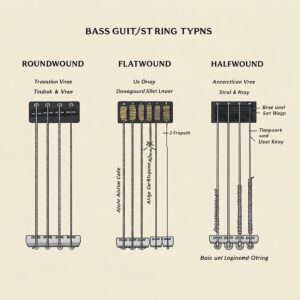
Conclusion
The humble bass guitar string represents far more than a simple component—it’s the literal connection between your musical ideas and their sonic realization. As we’ve explored throughout this comprehensive guide, the best bass strings for your needs depend on numerous factors including playing style, instrument characteristics, and personal preferences.
Whether you choose the versatile reliability of D’Addario EXL170s, the bright punch of Rotosound Swing Bass, or the sophisticated warmth of Thomastik-Infeld flatwounds, your string selection fundamentally shapes your bass’s voice. By understanding the materials, constructions, and technical factors we’ve discussed, you’ll be empowered to make more informed choices that enhance your playing experience.
Remember that experimentation remains essential to discovering your ideal strings. What works perfectly for one bassist might not suit another, even with seemingly identical equipment and techniques. Be willing to explore different options, trust your ears, and consider how strings interact with your particular instrument and playing approach.
Most importantly, don’t underestimate the impact that changing your bass guitar strings can have on your musical journey. A fresh set of well-chosen strings can reinvigorate your relationship with your instrument, inspire new creative directions, and help you achieve the tone you’ve been hearing in your imagination. Your perfect sound might be just a string change away.
More FAQs
❓ How often should I change my bass guitar strings?
✅ For roundwound strings, typically every 1-3 months with regular playing. Flatwound strings can last 1-2 years or longer. Replace when you notice tone degradation, difficulty maintaining intonation, or visible corrosion...
❓ What are the best bass guitar strings for slap technique?
✅ Stainless steel roundwound strings like Rotosound Swing Bass 66 or DR Hi-Beams provide the brightness and response needed for effective slapping. Medium-light gauges (.045-.105) offer ideal tension for thumb slaps and finger pops...
❓ Are flatwound bass strings worth the higher cost?
✅ Yes, flatwounds typically last 5-10 times longer than roundwounds, making them economical despite higher initial cost. They provide smooth playability, minimal finger noise, and warm tone ideal for jazz, Motown, and classic rock styles...
❓ Will changing my bass strings significantly affect my tone?
✅ Absolutely. String material, construction, and age dramatically impact your bass tone. Fresh strings deliver more clarity and sustain, while different materials (nickel, steel, cobalt) and constructions (round, flat, tapewound) fundamentally change your sound...
❓ What bass guitar strings should beginners start with?
✅ Beginners should start with nickel-plated steel roundwound strings in light or medium-light gauge (.045-.105). Brands like D'Addario EXL170 or Ernie Ball Regular Slinky provide balanced tone, reasonable durability, and comfortable playability at affordable prices...
Recommended for You:
- 4 String Electric Bass Guitar: 10 Best Options for Beginners and Pros in 2025
- Nylon Strings vs Steel Strings: The Ultimate Guide to Choosing the Right Guitar Strings in 2025
- Flatwound Bass Strings: 7 Amazing Benefits for Smooth Playing & Warm Tone
Disclaimer: This article contains affiliate links. If you purchase products through these links, we may earn a small commission at no additional cost to you.
✨ Found this helpful? Share it with your friends! 💬🤗
